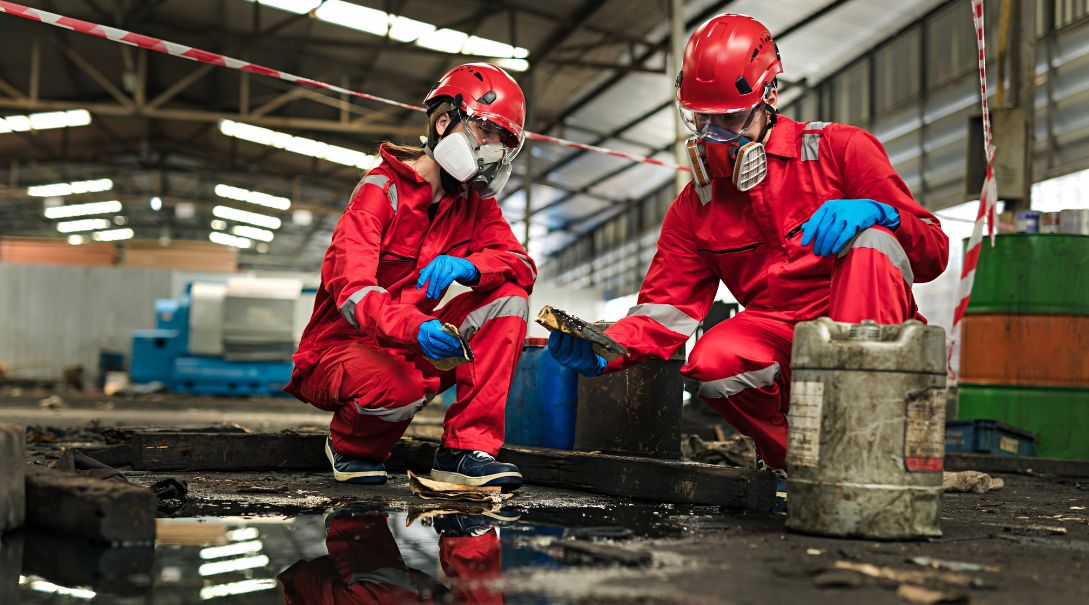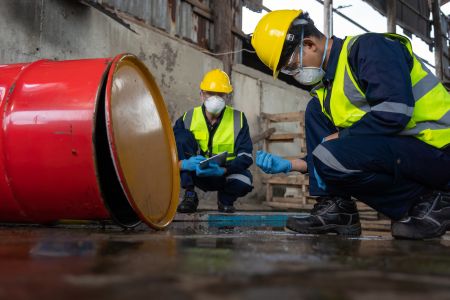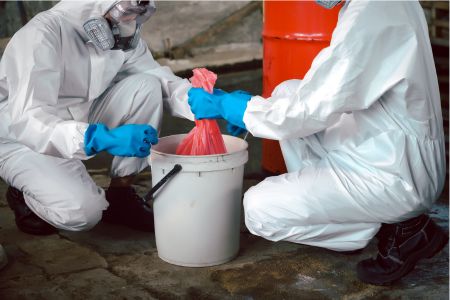Ensuring your distribution center is equipped with a robust spill response plan is crucial for maintaining a safe, compliant, and efficient operation. This guide to spill response in distribution centers introduces nine indispensable steps tailored to enhance spill management protocols. These steps ensure your facility is prepared to tackle spills head-on, safeguarding both the environment and your workforce.
Table of Contents
7 Steps To Effective Spill Response in Distribution Centers
Unfortunately, effective spill response in distribution centers is not a simple task. We break down the seven steps to effective spill response in distribution centers.
1. Immediate Incident Reporting
To ensure effective spill management from the moment of occurrence, follow these steps for incident reporting:
- Activate Spill Detection: If installed sensors detect a spill automatically, alert safety personnel immediately.
- Manual Reporting: Without automatic detection, employees who discover a spill should immediately use the nearest emergency reporting station or handheld device to report the incident.
- Provide Essential Information: Complete the report with critical details about the spill, including the exact location within the facility, the type and quantity of the substance, and any observed immediate hazards.
- Await Acknowledgement and Instructions: Once the report is submitted, wait for an acknowledgment from safety personnel. They will provide initial safety instructions and next steps.
These steps are designed to create a clear, efficient process for reporting immediate spills, establishing the foundation for a swift and effective response.
2. Assess the Situation: Detailed Actionable Steps
Accurately assessing the situation is crucial for an effective spill response in distribution centers. Follow these steps to ensure that you properly assess the spill:
Identify the Substance
- Consult Material Safety Data Sheets (MSDS): Quickly access the MSDS for the spilled substance to understand its properties, hazards, and handling instructions.
- Visual Identification: If the substance is known or labeled, use visual cues to confirm its identity, aiding in the immediate risk assessment.
Evaluate the Hazards
- Determine Immediate Risks: Assess the risk level based on the substance’s flammability, toxicity, corrosiveness, or environmental threat, which will dictate the urgency and nature of the response.
- Check for Secondary Hazards: Be aware of potential reactions with other substances or risks to nearby equipment and personnel.
Estimate the Scale of the Spill
- Measure or Estimate Spill Volume: Use available tools to measure or estimate the spill’s volume, considering the area covered and the depth of the substance.
- Assess the Affected Area: Identify the extent of the area affected by the spill, including any spread into sensitive locations like drains or adjacent workspaces.
Determine Protective Equipment Requirements
- Refer to MSDS and Safety Protocols: Based on the identified substance and assessed hazards, determine the required level of personal protective equipment (PPE) for anyone involved in the spill response.
- Prepare PPE Kits: Ensure that PPE kits containing gloves, goggles, respirators, or other necessary equipment are readily available and accessible to response personnel.
Decide on the Response Strategy
- Select Containment and Cleanup Methods: Choose appropriate containment measures (e.g., booms, absorbents) and cleanup methods based on the substance type and spill size.
- Plan for Waste Disposal: Adhere to environmental regulations and consider the requirements for disposing of the spilled substance and cleanup materials.
By methodically following these steps, you can ensure a thorough assessment of the spill situation, enabling a targeted and effective response that minimizes health risks, environmental impact, and operations disruption.
3. Secure the Area
Promptly securing the spill area is crucial to prevent unauthorized access and the spread of contaminants. Here are detailed steps to effectively isolate and protect the site:
Establish Perimeter
- Set Up Physical Barriers: Immediately erect physical barriers, such as cones, tape, or portable fences, around the spill area to create a visible boundary.
- Determine Buffer Zone: Establish a safety buffer zone beyond the immediate spill area to account for potential spread or exposure to hazardous fumes.
Deploy Signage
- Warning Signs: Place clear, understandable warning signs at all access points to the spill area. Signs should communicate the hazard and the prohibition of entry to unauthorized personnel.
- Informational Signage: Where possible, include details on the nature of the hazard (e.g., “Chemical Spill – No Entry”) to inform potentially affected personnel of the specific risks.
Control Access
- Assign Spill Monitors: Designate trained personnel to monitor access points, ensuring only authorized and properly equipped spill response team members can enter the area.
- Record Entry and Exit: To maintain accountability and enhance safety, keep a log of all individuals who enter and exit the spill zone, including times and durations.
Prevent Contamination Spread
- Cover Drains and Vents: Use covers, plugs, or sealants to block nearby drains, vents, or other openings that could allow the spill to spread outside the isolated area.
- Deploy Absorbent Materials: Strategically place absorbent materials or containment booms at the perimeter of the spill to prevent further spread, especially towards sensitive areas or waterways.
Communicate with Facility Personnel
- Facility-Wide Alert: As appropriate, issue a facility-wide alert to inform all personnel of the spill and its location, emphasizing the importance of avoiding the area.
- Update as Necessary: As the response progresses, provide updates on the situation and any changes to access restrictions or safety precautions.
Evaluate Environmental Impact
- Monitor for Environmental Hazards: Continuously assess the potential environmental impact, particularly if the spill occurs near outdoor areas, and implement additional containment measures as needed.
By systematically following these steps to secure the area, you ensure the safety of personnel, prevent the spread of contaminants, and lay the groundwork for an effective cleanup and recovery process.
4. Implement Spill Containment Measures
Once the area is secured, the next critical step in spill management is to contain the spill efficiently to minimize environmental damage and facilitate cleanup. Here are the steps to spill containment in distribution centers:
Block Drains and Seal Off Areas
- Cover Drains: Use drain covers, plugs, or sealant materials to prevent the spill from entering the drainage system, reducing the risk of waterway contamination.
- Seal Off Vents and Doorways: For indoor spills, seal off vents, doorways, and other openings to prevent fumes or liquids from spreading to other parts of the facility.
Select Appropriate Containment Materials
- Identify Suitable Absorbents: Choose absorbents compatible with the spilled substance, such as pads, rolls, or granular materials for chemicals, oil, or water-based liquids.
- Prepare Containment Booms: Use containment booms to encircle and contain the spill for larger spills, especially liquids.
Deploy Absorbents and Booms
- Strategically Place Absorbents: Position absorbents at the spill’s edges, working inward to prevent the spread. Ensure complete coverage of the spill perimeter.
- Install Containment Booms: Surround the spill with booms overlapping ends to create a sealed barrier, effectively containing the spill within a specified area.
Use Overpack Drums for Small Containers
- Transfer Leaking Containers: If the spill involves leaking containers, transfer them into overpack drums to contain the leakage and prevent the substance from spreading further.
Establish Secondary Containment
- Set Up Secondary Barriers: Establish secondary containment measures as an additional safeguard for significant spills or when the initial barriers are at risk of being breached.
Monitor and Adjust Containment Measures
- Continuous Monitoring: Regularly inspect the effectiveness of the containment measures, looking for signs of breach or spread beyond the contained area.
- Adjustment and Reinforcement: Quickly reinforce or adjust containment materials as needed based on ongoing assessments of the situation.
Document the Containment Process
- Record Actions and Materials Used: For compliance and future reference, keep detailed records of the containment measures implemented, including the types and quantities of materials used.
Communicate with the Response Team
- Update on Containment Status: The status of containment efforts should be regularly communicated to the spill response team and management, ensuring a coordinated approach to subsequent cleanup activities.
By meticulously implementing these spill containment measures, you can effectively minimize the spill’s impact on the environment and facility operations, setting the stage for a thorough and efficient cleanup process.
5. Spill Cleanup Procedures
After effectively containing the spill, the focus shifts to cleanup procedures. These steps are designed to ensure a safe, efficient, and thorough removal of the spill, minimizing environmental impact and restoring the area to its original condition.
Prepare for Cleanup
- Wear Appropriate PPE: Ensure all individuals involved in the cleanup wear the necessary personal protective equipment (PPE) based on the hazard assessment.
- Gather Cleanup Materials: Collect required cleanup materials, such as absorbents, neutralizers (for acids or bases), brooms, shovels, and waste disposal bags or containers.
Remove Spilled Material
- Apply Absorbents: Generously apply absorbents to the spill, starting from the outer edges and working towards the center.
- Neutralize Hazardous Spills: If dealing with acids or bases, carefully apply neutralizing agents according to the manufacturer’s instructions to mitigate hazards before cleanup.
- Collect and Contain Waste: Use brooms, shovels, or vacuum systems to collect absorbed materials or neutralized waste and transfer it to appropriate containers for disposal.
Decontaminate the Area
- Clean Surfaces: After removing the spill material, clean all surfaces affected by the spill using suitable detergents or cleaning agents to remove any residue.
- Rinse Thoroughly: Rinse the cleaned area with water (if applicable) to ensure all cleaning agents and any remaining residues are washed away.
- Dry the Area: Ensure the area is thoroughly dried to prevent falls, trips, and slips and to restore the area for safe use.
Facilities can effectively manage spill incidents by meticulously following these spill cleanup procedures, ensuring safety, compliance, and environmental protection.
6. Waste Disposal
Proper disposal of waste generated during the spill cleanup is essential for environmental protection and compliance with regulatory requirements. Consider following these waste disposal steps:
Segregate Waste
- Separate Hazardous from Non-hazardous: Distinguish between hazardous and non-hazardous waste materials and keep them in separate containers to avoid cross-contamination and simplify disposal processes.
Label Containers
- Clearly Mark Waste: Use labels to indicate each waste container’s contents, including hazard symbols if applicable, ensuring proper handling during disposal and compliance with regulations.
Use Appropriate Containers
- Select Certified Containers: When handling hazardous materials, use containers certified for hazardous waste and ensure they are appropriately sized and made of materials compatible with the waste.
Handle and Transport Safely
- Follow Handling Guidelines: Ensure personnel handling waste are trained in safe handling practices and wear the necessary PPE.
- Secure Transport: Only approved methods and vehicles should be used for transporting hazardous waste. Additionally, containers should be securely sealed and placed to prevent spills during transport.
Dispose According to Regulations
- Identify Disposal Facilities: Locate approved disposal facilities for hazardous and non-hazardous waste. Ensure these facilities are certified to handle the specific types of waste you’re disposing of.
- Adhere to Legal Requirements: Comply with local, state, and federal waste disposal regulations, including completing necessary paperwork, such as waste manifests for hazardous waste.
Document Disposal
- Keep Records: Maintain detailed records of the disposal process, including types and quantities of waste, disposal methods, and the destination of disposed materials. Retain copies of any manifests or receipts from disposal facilities.
7. Decontamination
After a spill cleanup, decontamination of the area, equipment, and personnel involved is crucial to remove any residual contaminants and restore safety. Consider following these steps for effective decontamination:
Prepare Decontamination Area
- Set Up Decontamination Zones: Establish clearly marked decontamination zones near the cleanup site for personnel, equipment, and any vehicles used during the cleanup.
- Provide Decontamination Supplies: Equip the area with water hoses, detergent, decontamination solutions, scrub brushes, and disposable towels or wipes.
Decontaminate Personnel
- Use Decontamination Showers: Require all individuals exiting the spill area to go through decontamination showers or wipe-down procedures to remove contaminants from skin and PPE.
- Handle Contaminated PPE Properly: Dispose of or properly clean contaminated PPE according to the type of spill and level of contamination.
Clean Equipment and Tools
- Wash Surfaces Thoroughly: Use detergents and decontamination solutions to clean tools, equipment, and protective gear that came into contact with the spill.
- Inspect and Test Equipment: After cleaning, inspect equipment for damage and test for proper operation before returning to service.
Decontaminate Vehicles
- Vehicle Washdown: If vehicles were used in the spill response, wash them down in a designated area to prevent the spread of contaminants. Collect wash water for proper disposal.
Final Area Rinse
- Rinse Spill Area: After removal of contaminants and waste, rinse the spill area with water or appropriate cleaning solutions to remove any remaining residues.
- Dry and Ventilate: Ensure the area is thoroughly dried and well-ventilated to remove any lingering vapors or moisture.
Monitor for Residual Hazards
- Conduct Hazard Assessment: After decontamination, assess the area for any residual hazards or potential for re-contamination. If necessary, use detection equipment to monitor air or surfaces.
Document the Decontamination Process
- Record Keeping: Document the decontamination procedures used, including chemicals and equipment, personnel involved, and any waste disposal actions. Maintain these records for regulatory compliance and future reference.
Benefits of Effective Spill Response
An effective spill response strategy is critical for distribution centers and facilities handling hazardous materials. The advantages of a successful spill response in distribution centers extend well beyond immediate incident management, offering long-term value in several key areas:
Minimizes Environmental Impact: Effective spill containment and cleanup procedures significantly reduce the risk of pollutants reaching waterways and soil, helping protect local ecosystems and wildlife and demonstrating a commitment to environmental stewardship and sustainability.
Ensures Regulatory Compliance: Adhering to established spill response protocols aligns operations with environmental regulations, avoiding potential fines and legal issues. It reflects a proactive approach to compliance, showcasing the facility’s dedication to operating within legal frameworks.
Protects Employee Health and Safety: Quick and efficient spill response actions minimize employees’ exposure to hazardous substances, enhancing workplace safety. It underscores the organization’s commitment to creating a safe working environment, contributing to employee well-being and morale.
Reduces Cleanup Costs and Downtime: Quickly addressing spills in distribution centers can significantly lower the overall costs associated with incident management, including cleanup expenses and operational disruptions. This efficiency helps maintain operational continuity and reduces the facility’s financial burdens.
Preserves Company Reputation: Demonstrating an ability to effectively manage and mitigate spills reinforces the company’s reputation as a responsible and environmentally conscious entity. This positive public image can enhance customer trust and loyalty.
Enhances Operational Continuity: Effective spill management ensures that disruptions to operations are minimized, maintaining the flow of goods and services. This operational resilience is crucial for meeting customer demands and maintaining supply chain integrity.
Strengthens Stakeholder Confidence: Transparent and efficient spill response strategies for distribution centers bolster confidence among investors, customers, and the community. This trust is foundational for building strong relationships and securing support for future endeavors.
By prioritizing effective spill response in distribution centers, facilities not only address the immediate challenges of spill incidents but also leverage these actions to support broader operational, environmental, and social goals.
Contact us today to safeguard your operations, protect the environment, and ensure compliance. Let’s work together towards a safer, more resilient future.
Get Professional Cleanup Assistance From AOTC
Effective spill response in distribution centers is crucial for maintaining safety, compliance, and environmental integrity in the dynamic world of distribution and logistics. Beyond immediate spill containment and cleanup, a robust response strategy enhances operational continuity, safeguards employee health, and fortifies your company’s reputation.
For businesses operating in Florida, Georgia, and Alabama, where environmental and regulatory stakes are high, expert emergency spill response services are essential. Our team offers rapid, 24/7 emergency spill response tailored to your specific needs, ensuring you’re prepared for any incident.
Contact us today to safeguard your operations, protect the environment, and ensure compliance. Let’s work together towards a safer, more resilient future.


